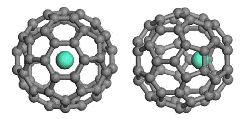Department of Chemistry
Document Type
Article
Date of this Version
1-15-2004
Abstract
The melting line is an important thermodynamic property of materials and can be calculated via computer simulation, given the intermolecular potential for the materials. Conventionally, the free-energy method has been mainly employed to calculate the melting line. Alternatives to the free-energy method for calculating the melting line include simulation of the solid-liquid coexistence and nonequilibrium molecular dynamics (MD) method. Recently, one of us (Morris) and Song reported a detailed simulation procedure to calculate the melting line of the Lennard-Jones system. Specifically, the MD simulation consists of a preparation run and a production run. In the preparation run, the liquid and solid subsystems are separately equilibrated in a constant volume, particle number, and energy (NVE) ensemble. In the production run, the two subsystems are joined together and then the total system evolves towards the thermodynamic equilibrium in the NVE ensemble. In this short note, we describe an improved preparation procedure for calculating melting lines of materials. This improved procedure is to address the anisotropic stress problem commented in the previous paper, that is, the principal components of stress tensor can be quite different during the production MD run if the initial lattice constant of the solid phase or the periodic boundary conditions are not carefully chosen. This anisotropy in stress can be quite substantial for hard solids such as the silicon, which renders the determination of the melting pressure difficult. We have tested the improved method with two empirical models of silicon: the Stillinger–Weber (SW) model and the Tersoff-89 model, as for both models the melting point at zero pressure has been determined previously via other methods.



Comments
Published by American Institute of Physics. J. Chem. Physics VOLUME 120, NUMBER 3, 15 JANUARY 2004. ©2004 American Institute of Physics. Permission to use. http://jcp.aip.org/.